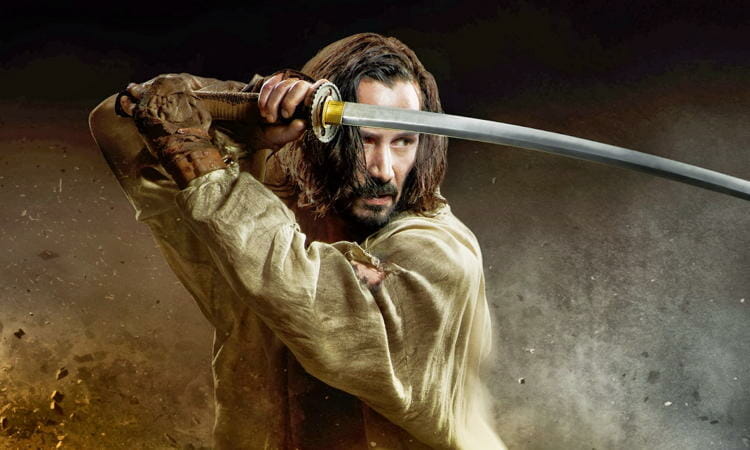By Nguyen Le · December 28, 2013

From paintings by Katsushika Hokusai, the numerous bunraku and kabuki plays and, heck, even making sushi, visual appeal is just an added ingredient to the experience in Japanese art. In the case of 47 Ronin, style is the main element employed to shroud its poor substance.
After their master is framed and forced to die, forty-seven samurai – among them a half-English, half-Japanese man – begin to seek vengeance in a land filled with magic and monsters. Leaving the foreign character and fantasy bits aside, the 47 Ronin tale is Japan’s most famous true story. Every year on December 14, the temple that house these warriors’ graves hold a ceremony to pay tribute to this fine example of honor and loyalty. Recreations of the tale – or chūshingura – are plenty, spanning across many years and media. With such quality and longevity, a Hollywood twist on the material is to be expected, but it is astounding how subpar the final product is even with the big budget and ideas involved.
From the narrated opening moments, there’s clunkiness all over: inconsistent storytelling techniques, odd editing choices and a minor character receiving a leading man-style introduction. The latter detail is referring to Kai, a character so lifeless, whose accent is dropped as he grows up and so forcibly integrated that without him, or even Keanu Reeves, the movie would still function. While Kai and the actor who played him’s significance to the plot is questionable, there’s certainty about their significance to the film though. Being the only face the Western world recognizes after Speed and The Matrix, much like Tom Cruise in The Last Samurai, Reeves is there to explain Japanese concepts a Western audience might find uncommon, including ronin (a masterless samurai), seppuku (ritual suicide) and bushido (the values of a samurai). Unlike Nathan Algren though, Kai has no dimension, charisma and energy for viewers to invest or connect and as a result, the clarifying work comes off as lazy and flat.
The Japanese cast fortunately is better. It helps that most of them are Japanese cinema’s well-known faces, some on a national level – 2003 Japanese Academy Prize’s winner Min Tanaka (Lord Asano) and J-horror beauty Ko Shibasaki (Kai’s love interest Mika) – as well as international – there’s Rinko Kikuchi (The Witch) who turned in a wordless but Oscar-nominated performance in Babel, Hollywood star Cary-Hiroyuki Tagawa (Shogun, or war commander, Tsunayoshi), one of Thor’s friends is played by Tadanobu Asano (the film’s villain Lord Kira) and LOST alumnus Hiroyuki Sanada. Even with little screen-time, the Japanese cast display engagement in their roles. The highlight goes to Sanada though. As leader of the 47, he brings a commanding presence, intensity and adequate emotional weight as Oishi, rendering him as the true shoulders that carry the film. What is supposed to be a role that allows Sanada to act more than his mostly-mute turn in The Last Samurai is ruined by Reeves. With the movie shifting its focus between Reeves’s Kai and Sanada’s Oishi, neither characters are memorable by the film’s end.
In fact, none of the characters are worth noting thanks to a script that is filled with expository moments, thin on elaborating its fantasy elements and too impatient to thoroughly explore its characters or locations. Strange how 47 Ronin has the ingredients that are apparent in the more average scripts penned by Chris Morgan and Hossein Amini i.e. Tokyo Drift and Snow White and the Huntsman, respectively. What happened to the Morgan that conjure the entertaining action scenes in Fast Five and the Amini that demonstrate skillful characterization in Drive? The editing does little to help both of them, hopping from one angle to another in meaningless fashion during combat sequences, resulting in the invention of two games called “blink and miss” and “spot that weird CGI”. The biggest editing oddity has to be the where Oishi rescues Kai from Dutch pirates in Dejima. Spending only mere minutes here, this part could have easily been cut out instead of causing bewilderment and confusion. While not as severe as the pirates, almost all of the fantasy elements are underdeveloped: the Witch and the giant samurai aren’t fleshed-out at all, ghosts in the bamboo forest are only glimpsed at, there are demons in monks’ clothing for Buddha knows why and Kai’s entire backstory are revealed through a villain’s monologue. Why have the fantasy elements, the very reason this film exists in the first place, when they are treated like afterthoughts?
Speaking of afterthoughts, that’s clearly not the approach of cinematographer John Mathieson (Gladiator and X-Men First Class), costume designer Penny Rose (Pirates of the Caribbean series) and production designer Jan Roelfs (Gattaca). The work of these three complement each other beautifully on-screen, making each frame vibrant when they need to, dramatic if they must be, and depressing should the plot call for it. The trio deserves the highest credit.
Other good but not as noteworthy things include the now-and-then rousing score from Ilan Eshkeri (Stardust) and the visual effects. No stranger to CGI-filled creations, whenever he could director Carl Rinsch will let them fill the screen and viewers are only able to be in awe should the editor allow it. As a result, pivotal sequences are a let-down while moments such as when the Witch transforms into a formless kimono, a ghost of the bamboo forest manifests itself, and a close-up of a 6-eyed beast are main highlights. At only 30 seconds or a couple of minutes, Rinsch’s commercials are more delightful than his first 2-hour film.
47 Ronin fails to be a good movie out of a fascinating pitch. Even with intensely beautiful distractions, they are not effective enough to disguise the gigantic lumps. For better ways of knowing about the 47 Ronin, book a ticket to Japan on December 14 or, since it’s still the recession, search for copies of the acclaimed 1962 movie Chūshingura.